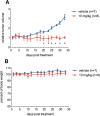Identification of a Potent Inhibitor of CREB-Mediated Gene Transcription with Efficacious in Vivo Anticancer Activity
- PMID: 26023867
- PMCID: PMC4493896
- DOI: 10.1021/acs.jmedchem.5b00468
Identification of a Potent Inhibitor of CREB-Mediated Gene Transcription with Efficacious in Vivo Anticancer Activity
Abstract
Recent studies have shown that nuclear transcription factor cyclic adenosine monophosphate response element binding protein (CREB) is overexpressed in many different types of cancers. Therefore, CREB has been pursued as a novel cancer therapeutic target. Naphthol AS-E and its closely related derivatives have been shown to inhibit CREB-mediated gene transcription and cancer cell growth. Previously, we identified naphthamide 3a as a different chemotype to inhibit CREB's transcription activity. In a continuing effort to discover more potent CREB inhibitors, a series of structural congeners of 3a was designed and synthesized. Biological evaluations of these compounds uncovered compound 3i (666-15) as a potent and selective inhibitor of CREB-mediated gene transcription (IC50 = 0.081 ± 0.04 μM). 666-15 also potently inhibited cancer cell growth without harming normal cells. In an in vivo MDA-MB-468 xenograft model, 666-15 completely suppressed the tumor growth without overt toxicity. These results further support the potential of CREB as a valuable cancer drug target.
Figures














Similar articles
-
Structure-activity relationship studies of naphthol AS-E and its derivatives as anticancer agents by inhibiting CREB-mediated gene transcription.Bioorg Med Chem. 2012 Dec 1;20(23):6811-20. doi: 10.1016/j.bmc.2012.09.056. Epub 2012 Oct 4. Bioorg Med Chem. 2012. PMID: 23102993 Free PMC article.
-
The peptide-hormone glucagon-like peptide-1 activates cAMP and inhibits growth of breast cancer cells.Breast Cancer Res Treat. 2012 Apr;132(2):449-61. doi: 10.1007/s10549-011-1585-0. Epub 2011 Jun 3. Breast Cancer Res Treat. 2012. PMID: 21638053
-
Small molecule nAS-E targeting cAMP response element binding protein (CREB) and CREB-binding protein interaction inhibits breast cancer bone metastasis.J Cell Mol Med. 2019 Feb;23(2):1224-1234. doi: 10.1111/jcmm.14024. Epub 2018 Nov 20. J Cell Mol Med. 2019. PMID: 30461194 Free PMC article.
-
Design, synthesis and biological evaluation of regioisomers of 666-15 as inhibitors of CREB-mediated gene transcription.Bioorg Med Chem Lett. 2017 Feb 15;27(4):994-998. doi: 10.1016/j.bmcl.2016.12.078. Epub 2016 Dec 31. Bioorg Med Chem Lett. 2017. PMID: 28073675 Free PMC article.
-
Cyclic AMP-regulatory element-binding protein: a novel UV-targeted transcription factor in skin cancer.Photochem Photobiol Sci. 2024 Jun;23(6):1209-1215. doi: 10.1007/s43630-024-00578-7. Epub 2024 May 14. Photochem Photobiol Sci. 2024. PMID: 38743195 Review.
Cited by
-
Excitotoxic glutamate levels drive spinal cord ependymal stem cell proliferation and fate specification through CP-AMPAR signaling.Stem Cell Reports. 2023 Mar 14;18(3):672-687. doi: 10.1016/j.stemcr.2023.01.005. Epub 2023 Feb 9. Stem Cell Reports. 2023. PMID: 36764296 Free PMC article.
-
Disruption of mitochondrial homeostasis with artemisinin unravels anti-angiogenesis effects via auto-paracrine mechanisms.Theranostics. 2019 Sep 17;9(22):6631-6645. doi: 10.7150/thno.33353. eCollection 2019. Theranostics. 2019. PMID: 31588240 Free PMC article.
-
Chemical modulation of transcription factors.Medchemcomm. 2018 Jul 11;9(8):1249-1272. doi: 10.1039/c8md00273h. eCollection 2018 Aug 1. Medchemcomm. 2018. PMID: 30151079 Free PMC article. Review.
-
Vasoactive intestinal peptide controls the suprachiasmatic circadian clock network via ERK1/2 and DUSP4 signalling.Nat Commun. 2019 Feb 1;10(1):542. doi: 10.1038/s41467-019-08427-3. Nat Commun. 2019. PMID: 30710088 Free PMC article.
-
ETS1 is associated with cisplatin resistance through IKKα/NF-κB pathway in cell line MDA-MB-231.Cancer Cell Int. 2018 Jun 19;18:86. doi: 10.1186/s12935-018-0581-4. eCollection 2018. Cancer Cell Int. 2018. PMID: 29950928 Free PMC article.
References
-
- Shaywitz A. J.; Greenberg M. E. CREB: A stimulus-induced transcription factor activated by a diverse array of extracellular signals. Annu. Rev. Biochem. 1999, 68, 821–861. - PubMed
-
- Mayr B.; Montminy M. Transcriptional regulation by the phosphorylation-dependent factor CREB. Nat. Rev. Mol. Cell Biol. 2001, 2, 599–609. - PubMed
-
- Radhakrishnan I.; Perez-Alvarado G. C.; Parker D.; Dyson H. J.; Montminy M. R.; Wright P. E. Solution structure of the KIX domain of CBP bound to the transactivation domain of CREB: A model for activator:coactivator interactions. Cell 1997, 91, 741–752. - PubMed
-
- Hagiwara M.; Alberts A.; Brindle P.; Meinkoth J.; Feramisco J.; Deng T.; Karin M.; Shenolikar S.; Montminy M. Transcriptional attenuation following cAMP induction requires PP-1-mediated dephosphorylation of CREB. Cell 1992, 70, 105–113. - PubMed
Publication types
MeSH terms
Substances
Grants and funding
LinkOut - more resources
Full Text Sources
Other Literature Sources
Medical
Research Materials
Miscellaneous

